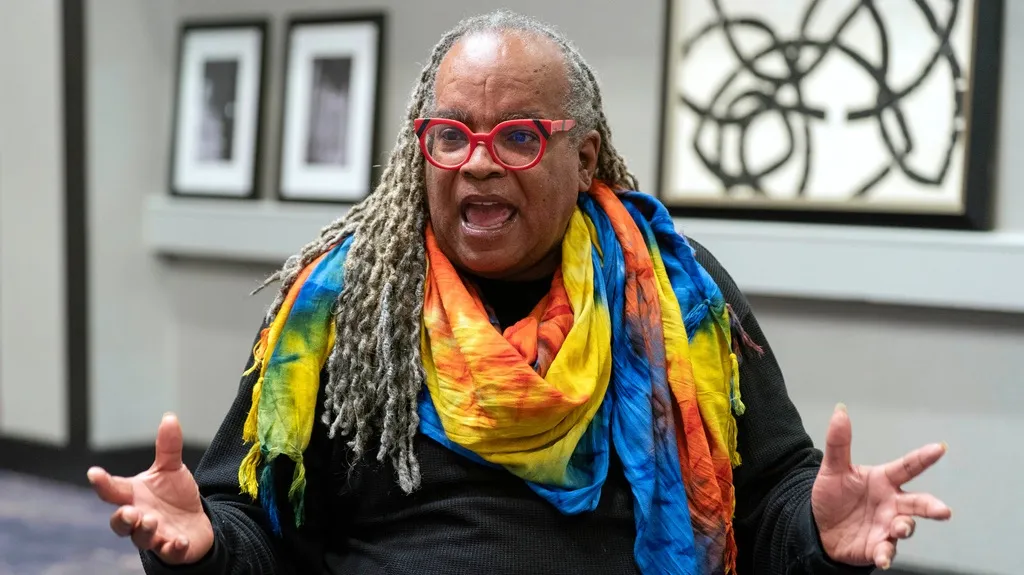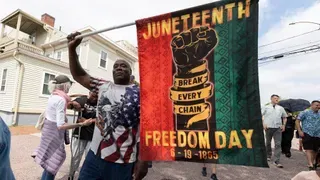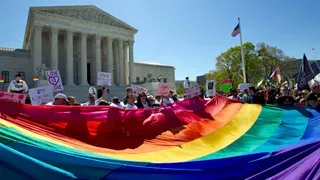October 5, 2010
Bowing to Trans Pressure, D.C. Starbucks Switching to Gender-Neutral Restrooms
Kilian Melloy READ TIME: 8 MIN.
Washington, D.C.-area Starbucks coffee shops have made the switch from gender-specific to gender-neutral restrooms in the wake of efforts from gay and trans equality groups.
Amanda Hess reported on Oct. 1 at her TBD blog that the switch would be ongoing throughout the month. The process of changing the single-occupant restrooms in all of the D.C. area's 52 Starbucks locations commenced Oct. 4.
The switch brings Starbucks into compliance with an ordinance that requires pubic restrooms to be accessible to trans and gender-nonconforming people. The blog posting reported that under a 2006 amendment to the District's Human Rights Act, "individuals [have] the right to use gender-specific restrooms and other gender-specific facilities such as dressing rooms, homeless shelters, and group homes that are consistent with their gender identity or expression."
Under the act's provisions, single-occupant restrooms are not supposed to be marked for use by patrons of a specific gender, but many area businesses have not replaced "Men's" and "Women's" signs with gender-neutral "Restroom" placards. The DC Trans Coalition launched an initiative in 2009 to promote awareness of the law, and compliance with it, by area businesses.
For corporate giant Starbucks to embrace the change sets a positive and high-profile example that will encourage "the entire business community to learn more about their responsibilities under the Human Rights Act and to become compliant if they have not already done so," according to Gustavo Velasquez, the director of the District's Office of Human Rights.
The issue of "restroom equity" has become something of a national concern for trans equality groups, as well as for foes of gender-neutral facilities and those opposed to rights and recognition for transgendered individuals. An Oct. 5 posting at Jezebel.com notes that the issue of transgendered school children has become a hot-button topic, with a case in Maine illustrating the tensions surrounding the issue.
Two separate rulings by the Maine Human Rights Commission affirmed the right of the student to use the restroom that corresponded with her gender identity, to the chagrin of opponents who call for rules about "biology-based bathrooms" that would restrict restroom use according to an individual's physiology.
The parents of the student, who was born physiologically male but who identifies as female, had initially won a case against the school district when the child was a fifth grader and denied use of the girls' room. Last month the student's family won a second case brought against the school district for having denied her use of the girls' restroom when she was in the sixth grade in 2008-2009.
The first complaint was leveled at Asa Adams Elementary, which is part of the Orono school district. The second complaint was brought against Orono Middle School.
The student's parents wrote that the school had "implicitly isolat[ed]" their child by requiring her to use a gender-neutral restroom, a policy that the parents said "alienat[ed her] from other students." The parents said that their child was ostracized. The child no longer goes to school in Orono's school district.
The school district countered that it had made a number of accommodations to the student short of allowing her to use the girls' restroom, including providing a restroom and locker room for the child's own use and meeting frequently with her parents. The school district's statement noted that the student "appeared to be happy and involved in the school community."
The panel noted that the student had been subjected to harassment and ridicule, and referenced an occasion on which a boy hurled anti-gay invective at her.
The Maine Human Rights Commission had contemplated drafting non-discrimination policies for sexual minorities following the earlier decision in favor of the transgendered student, but at that time the lawyer for Orono School Department foresaw difficulties for Maine schools should they attempt to implement such policies. Meantime, some parents (and grandparents) took exception with the ruling, saying that boys and girls belong in their designated washrooms.
However, for GLBT equality groups, the commission's finding is a step forward for a poorly understood population that is often subjected to vilification and misunderstanding. Transgendered individuals perceive, innately and unchangeably, that they are of a given gender--even if their physical characteristics belong to the other gender. Thus, a transgendered child may insist that she is a girl, even if anatomically she is male.
Gender transitions often may or may not involve surgical procedures. They may be non-surgical in nature, consisting of hormone treatments and lifestyle changes, and stopping short of surgical reconstruction. Even without surgery, a woman in a man's body may begin wearing women's clothing and makeup. Gender transitions also reportedly give a sense of peace and rightness to transgendered individuals, who may never have felt comfortable in the gender roles and clothing assigned to them by society at large. The incidence of transgenderism is low, but transgendered people are common enough that such debates and controversies are becoming more frequent.
Because transgendered individuals experience a deep-seated and persistent conviction that they actually belong to the other sex, regardless of their anatomical characteristics, very young children might declare themselves to be girls, or boys, to the consternation of their parents--who naturally may be inclined to see their child's gender according to his or her anatomy, rather than the child's internal sense of who he or she fundamentally is.
The depth and duration of a transgendered child's conviction of belonging to the gender opposite his or her anatomy far exceeds any transient phase when a child might pretend to be the other gender. In many cases, transgendered adults recall being convinced from early life of their true gender identification.
Sexual Identity and Sexual Orientation Separate Issues
But society at large does not yet comprehend the differences between sexual identity and sexual orientation, and often the idea that a child can have a clear and distinct sense of his or her own gender is dismissed. Nonetheless, some child health professionals have begun to recognize that children may know better for themselves who they are than the adults around them--and some advise that parents, educators, and other caregivers allow the children to take the lead in such cases.
But there are practical considerations to be taken into account when the question of restroom equity comes to schools, pointed out attorney Melissa Hewey, who represented the school department. In a June 30, 2009, Bangor Daily News article, Hewey said of the panel's initial finding, "I'm not sure that it takes into account practicalities that face educators around the state. You can understand [the ruling] intellectually. You can agree with it intellectually. But practice is sometimes different--and I think that's what may have escaped some people in this case."
Though the ruling might result in heated debate and uncertainties about how to accommodate transgendered school children, the Maine Civil Liberties Union's legal director, Zachary Heiden, saw the ruling as a mark of progress, the article reported. "This ruling is a huge step forward for a vulnerable population that is entitled to the full protection of the law," said Heiden. "There will always be voices who claim we're not ready, we're not there yet, the time to end discrimination is next year, or next session. But victims of discrimination should not have to wait."
In the political arena, the issue of restroom equity versus biology-based bathrooms has become a new, though lesser-known flashpoint in the culture wars. The issue of trans access to gender identity-appropriate restrooms was muddied in Tampa, Florida, last year by religious and anti-gay groups seeking to play up fears of sexual predation taking place in women's lavatories under the guise of trans protections.
Anti-gay religious Web site WorldNetDaily reported in a Nov. 18, 2009, article that Tampa's city council had passed a measure to include trans citizens under an existing anti-discrimination ordinance. Fears about sexual predators exploiting the measure were exploited by anti-gay groups such as the American Family Association (AFA), which put out a statement recalling an incident involving a sex offender who had illegally been in a women's area of a fitness center.
Charges of anti-Christian persecution quickly followed. "We're trying to mobilize people to stand in opposition to what is a bad law [that] discriminates against Christians and provides special privileges for people based on sexually aberrant behavior," claimed the president of the Community Issues Council, Terry Kemple.
"This is intended to address people who are dealing with gender identity," said Chip Fletcher, Tampa's city attorney. As such, the law applies to individuals who are transitioning to the other gender anatomically, so their bodies come into alignment with their personal perceptions of their own genders.
But the president of the anti-gay American Family Association, Tim Wildmon, gave the story a different spin, claiming that school children would be affected by the inclusion of trans individuals under the ordinance. "The gender identity ordinance also provides legal protection for transgenders to teach schoolchildren one day as a man and another day as a woman," asserted Wildmon in an email. "Unfortunately, the ordinance does not attempt to qualify who really is a transgender and who is not. That is left up to the individual to determine what his 'gender identity' is that day."
Kemple cast the issue as one in which religious political clout must be used in order to prevent the erosion of religious freedoms, reported a Nov. 17, 2009, article in the Tampa Tribune that was posted at Tampa Bay Online. "If the city council hears a loud voice from the church they'll think twice and we may actually defeat this proposal," declared Kemple. "If they don't hear from us be ready to lose a few more of the religious freedoms our country was established to protect."
The same article noted that Tampa city council had approved the change unanimously on Nov. 5, joining 16 other Florida towns in offering trans protections. Across the country, over a dozen states and a number of large companies--well over three-quarters of Fortune 500 companies--have also acted to provide trans protections. Without protections in place for trans individuals, noted Nadine Smith, Equality Florida's executive director, trans citizens could face loss of employment, be denied housing, and find themselves ejected from restaurants and other public places. Smith called Tampa's inclusion of trans citizens under the city's anti-discrimination ordinance "long overdue," adding, "This is what big cities do to protect their citizens."
Anti-gay groups have employed what equality advocates dub "scare tactics" in other areas of the country as progress for trans protections has continued. In Colorado, as in Tampa, rhetoric around denying trans individuals protections centered on restroom usage. James Dobson, the head of the anti-gay organization Focus on the Family, which is headquartered in Colorado Springs, Colo., issued a warning that predicted dire consequences. "Henceforth, every woman and little girl will have to fear that a predator, bisexual, cross-dresser or even a homosexual or heterosexual male might walk in and relieve himself in their presence," Dobson declared.
Responded Colorado State Senator Jennifer Veiga, "[Equality opponents] can point to absolutely no example that this happened in Colorado" or any of the 16 states where trans people are included in anti-discrimination protections.
A lack of precedent has not deterred opponents from carrying their fight against trans equality to the federal level. The Obama Administration has worked with lawmakers to pass a trans-inclusive version of the Employment Non-Discrimination Act (ENDA).
One model already in use for accommodating trans workers is Nike's policy of allowing its employees to use the restrooms and locker rooms set aside for the genders with which they identify. Special areas of those facilities are provided to grant additional privacy.
Kilian Melloy serves as EDGE Media Network's Associate Arts Editor and Staff Contributor. His professional memberships include the National Lesbian & Gay Journalists Association, the Boston Online Film Critics Association, The Gay and Lesbian Entertainment Critics Association, and the Boston Theater Critics Association's Elliot Norton Awards Committee.







